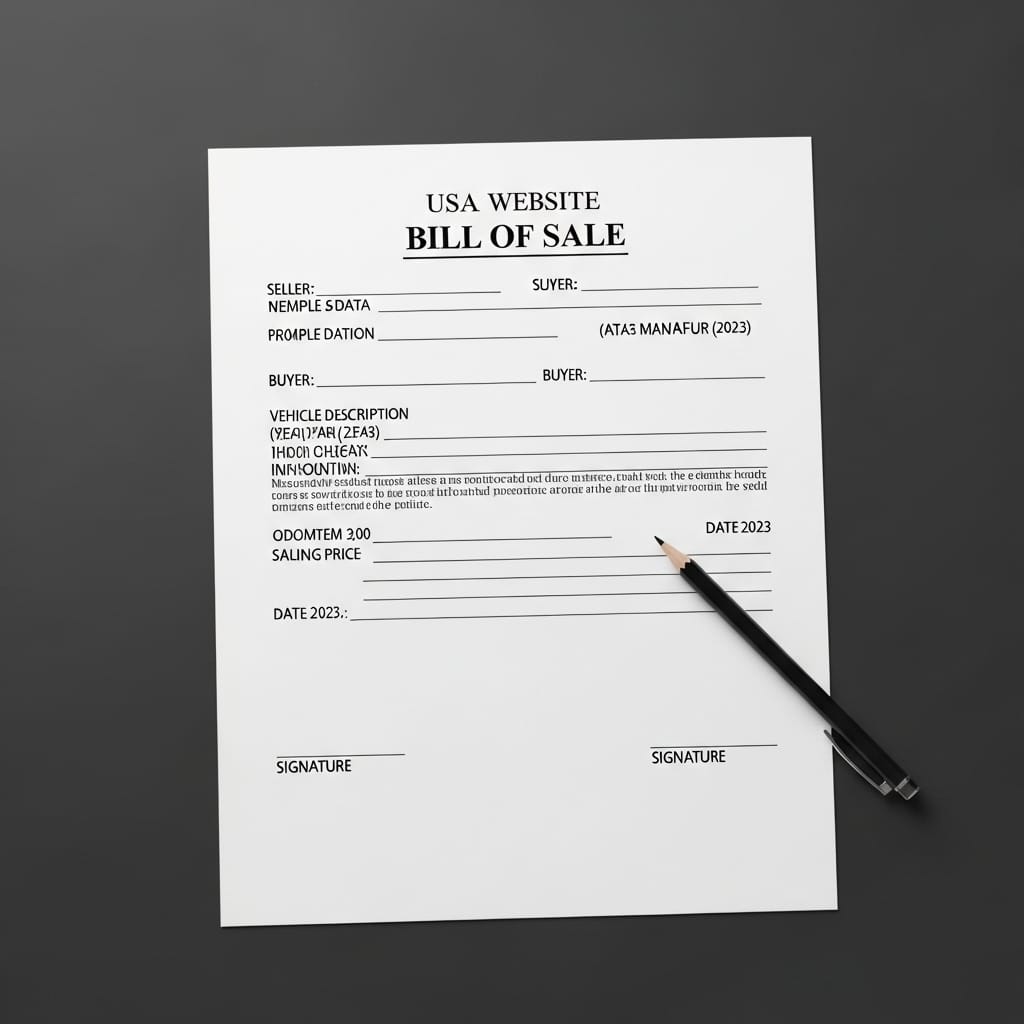
The Ultimate Guide to a Bill of Sale: Your Key to a Secure Transaction
In the bustling marketplace of private sales, where everything from classic cars to vintage furniture changes hands every second, there exists a simple yet profoundly important document: the bill of sale. Too often overlooked as a mere formality or a simple receipt, a well-crafted bill of sale is, in reality, a powerful legal instrument. It’s the silent guardian in a transaction, the official handshake that solidifies an agreement, and the definitive proof of a new beginning for an item and its owner. Whether you are selling your trusty first car or buying a secondhand laptop, understanding the ins and outs of a bill of sale isn’t just good practice—it’s essential for your financial security and peace of mind.
This comprehensive guide will walk you through everything you need to know. We’ll explore what a bill of sale truly is, why it’s indispensable for both buyers and sellers, how to craft an ironclad one, and the specific nuances for different types of property. Think of this as your complete roadmap to navigating the transfer of ownership with confidence and clarity.
What Exactly is a Bill of Sale? More Than Just a Receipt
At its core, a bill of sale is a legal document that records the transfer of title to personal property from one person (the seller) to another (the buyer). While it shares similarities with a sales receipt, it carries significantly more weight. A receipt simply acknowledges that payment was made. A bill of sale, however, does much more: it formally documents the change in ownership.

This document serves as tangible evidence of the transaction. It details the “who, what, when, where, and how much” of the sale, creating a clear record that can be invaluable for resolving disputes, proving ownership, or for official purposes like registering a vehicle or boat. It’s the narrative of the transaction, written down and signed, providing a layer of legal protection that a simple verbal agreement or a flimsy receipt can never offer.
Why You Absolutely Need a Bill of Sale: A Tale of Two Perspectives
The true beauty of a bill of sale lies in its dual-sided protection. It’s not just for the buyer or just for the seller; it’s a foundational element of trust and security for both parties involved.
For the Seller: Your Shield of Protection
As a seller, once an item leaves your possession, you want the transaction to be final. The last thing you want is the buyer returning weeks later with complaints or, in a worst-case scenario, the item being used in an illicit activity and authorities tracing it back to you. A bill of sale is your official release of liability.
- Proof of Sale: It is your undeniable proof that you sold the item on a specific date. This prevents any fraudulent claims that the item was stolen from you.
- Release from Liability: A properly worded bill of sale, especially one with an “as-is” clause, severs your responsibility for the item’s future performance or condition. If the car’s engine fails a month after the sale, the buyer cannot legally hold you responsible.
- Protection from Future Issues: If a vehicle you sold is later abandoned or involved in an accident before the new owner has officially transferred the title, the bill of sale demonstrates that you were no longer the owner at the time of the incident. This can save you from immense legal headaches, fines, and liability claims.
For the Buyer: Your Proof of Ownership
As a buyer, handing over your hard-earned cash can feel like a leap of faith. The bill of sale is your safety net, providing the concrete proof you need to confidently claim the item as your own.
- Evidence of Ownership: This is the most critical function for the buyer. The bill of sale is your primary document proving you are the new, rightful owner of the property.
- Essential for Registration and Title: For vehicles, boats, and sometimes even trailers, the Department of Motor Vehicles (DMV) or a similar state agency will not allow you to register the item or transfer the title into your name without a valid bill of sale.
- Insurance Purposes: Insurance companies may require a bill of sale to add a newly purchased item, like a boat or a valuable piece of equipment, to your policy.
- Resale Value: When it comes time for you to sell the item in the future, having the original bill of sale can add a layer of legitimacy and a clear history of ownership, making the item more attractive to potential buyers.
The Anatomy of an Ironclad Bill of Sale
A bill of sale doesn’t need to be filled with complicated legal jargon to be effective. However, it must contain specific, essential elements to be considered legally sound. Leaving out any of these details can render the document weak or even void.
Core Components:
- The Parties Involved: The full legal names and current residential addresses of both the seller and the buyer.
- The Date of the Transaction: The specific date (month, day, and year) on which the sale took place and possession of the item was transferred.
- The Purchase Price: The exact amount of money paid for the item. If the item was a gift or a trade, this should be clearly stated. For example, “a payment of $5,000” or “in exchange for one 2022 Riding Lawnmower” or “as a gift with no monetary consideration.”
- A Detailed Description of the Item: This is arguably the most crucial part. A vague description is a recipe for disaster. Be as specific as possible.
- For a Vehicle: Include the make, model, year, color, Vehicle Identification Number (VIN), and the odometer reading at the time of sale.
- For a Boat: Include the make, model, year, length, Hull Identification Number (HIN), and details about any included motor or trailer.
- For Electronics: Include the brand, model name, and serial number.
- For Furniture: Describe the type of item, material, color, and any distinguishing features or flaws.
- The “As-Is” Clause: A vital statement for the seller. It should clearly state that “The property described above is sold in ‘as-is’ condition, with the seller making no warranties, express or implied, regarding its condition or fitness for any particular purpose.”
- Signatures: The document must be signed and dated by both the seller and the buyer. A signature signifies that the party has read, understood, and agreed to the terms.
- Notary Public Acknowledgment (Optional but Recommended): While not always legally required, having the bill of sale notarized is a very smart move. A notary public verifies the identities of the signers, adding a powerful layer of authenticity and fraud prevention. Some states mandate notarization for certain sales, like vehicles.
Types of Bills of Sale: Not a One-Size-Fits-All Document
While the general format is consistent, bills of sale can come in a few different flavors, each serving a distinct purpose.
Absolute Bill of Sale
This is the most common type. It represents a complete and immediate transfer of ownership from the seller to the buyer. Once signed and the payment is made, the deal is done. The seller has no more claim to the property, and the buyer has full ownership, assuming all rights and responsibilities. The vast majority of private sales use an absolute bill of sale.
Conditional Bill of Sale
A conditional bill of sale places conditions on the transfer of ownership. It’s essentially a security agreement, often used when the buyer is purchasing an item through installments. The seller retains a security interest in the property, and full ownership only passes to the buyer once certain conditions are met—most commonly, the full payment of the agreed-upon price. If the buyer defaults on the payments, the seller may have the right to repossess the property, as outlined in the document’s terms.
A Closer Look: Bills of Sale for Specific Items
While a generic bill of sale can work for many items, certain types of property have specific requirements due to state regulations and the nature of the item itself.
The Vehicle Bill of Sale: Your Key to the DMV
When selling a car, truck, or motorcycle, a bill of sale is almost always a necessity. State DMVs have strict rules for proving ownership to issue a new title and registration. Beyond the basic components, a vehicle bill of sale absolutely must include the Vehicle Identification Number (VIN) and the exact odometer reading at the moment of sale. Falsifying an odometer reading is a federal offense, so accuracy is paramount. Both parties should verify the VIN on the document matches the VIN on the vehicle itself (usually found on the dashboard and the driver’s side doorjamb).
The Boat Bill of Sale: Navigating the Waters of Ownership
Similar to a vehicle, selling a boat requires a detailed bill of sale. The key identifier here is the Hull Identification Number (HIN). The document should clearly describe the boat (manufacturer, model, year, length) and list the HIN. If the boat’s motor has a separate serial number or if a trailer is included in the sale, these should be listed as separate items with their own descriptions and serial numbers on the same bill of sale.
The Firearm Bill of Sale: A Record for Responsibility
In the complex world of firearm transactions, a bill of sale is a critical document for private sales. While it does not replace the need to follow all federal, state, and local laws (which can vary dramatically), it creates a vital paper trail. For the seller, it proves they no longer possess the firearm. For the buyer, it proves their legitimate acquisition. The document should include the firearm’s manufacturer, model, caliber, and serial number. It’s also wise to include a statement that the buyer is legally permitted to own a firearm.
The “As-Is” Clause: Your Most Important Three Words
We’ve mentioned it before, but the “as-is” clause deserves its own spotlight because of its immense importance for the seller. When you sell an item “as-is,” you are legally stating that the buyer accepts it in its current condition, including any and all faults, whether they are obvious or hidden.
This simple phrase effectively disclaims any implied warranties. An implied warranty is an unspoken guarantee that an item will work for its intended purpose. By including the “as-is” clause, you are neutralizing this unspoken guarantee. The buyer is acknowledging that they have had the opportunity to inspect the item to their satisfaction and are assuming all risks for its future performance. Without this clause, you could be leaving the door open for the buyer to claim you sold them a defective product, potentially leading to demands for refunds or costly repairs.
Conclusion: The Humble Document with Mighty Power
In a world of complex contracts and agreements, the bill of sale stands out for its simplicity and strength. It is a cornerstone of a fair and transparent transaction, a document that empowers and protects both the person letting go of an item and the one welcoming it. It transforms a potentially risky exchange into a secure, verifiable event. So the next time you prepare to sell that old guitar or buy that dream speedboat, remember to harness the power of this humble document. Taking a few extra minutes to draft a thorough, accurate, and signed bill of sale is a small investment that pays massive dividends in security, clarity, and ultimate peace of mind.







